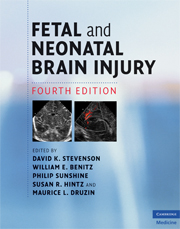Book contents
- Frontmatter
- Contents
- List of contributors
- Foreword
- Preface
- Section 1 Epidemiology, pathophysiology, and pathogenesis of fetal and neonatal brain injury
- Section 2 Pregnancy, labor, and delivery complications causing brain injury
- Section 3 Diagnosis of the infant with brain injury
- Section 4 Specific conditions associated with fetal and neonatal brain injury
- 22 Congenital malformations of the brain
- 23 Neurogenetic disorders of the brain
- 24 Hemorrhagic lesions of the central nervous system
- 25 Neonatal stroke
- 26 Hypoglycemia in the neonate
- 27 Hyperbilirubinemia and kernicterus
- 28 Polycythemia and fetal–maternal bleeding
- 29 Hydrops fetalis
- 30 Bacterial sepsis in the neonate
- 31 Neonatal bacterial meningitis
- 32 Neurological sequelae of congenital perinatal infection
- 33 Perinatal human immunodeficiency virus infection
- 34 Inborn errors of metabolism with features of hypoxic–ischemic encephalopathy
- 35 Acidosis and alkalosis
- 36 Meconium staining and the meconium aspiration syndrome
- 37 Persistent pulmonary hypertension of the newborn
- 38 Pediatric cardiac surgery: relevance to fetal and neonatal brain injury
- Section 5 Management of the depressed or neurologically dysfunctional neonate
- Section 6 Assessing outcome of the brain-injured infant
- Index
- Plate section
- References
29 - Hydrops fetalis
from Section 4 - Specific conditions associated with fetal and neonatal brain injury
Published online by Cambridge University Press: 12 January 2010
- Frontmatter
- Contents
- List of contributors
- Foreword
- Preface
- Section 1 Epidemiology, pathophysiology, and pathogenesis of fetal and neonatal brain injury
- Section 2 Pregnancy, labor, and delivery complications causing brain injury
- Section 3 Diagnosis of the infant with brain injury
- Section 4 Specific conditions associated with fetal and neonatal brain injury
- 22 Congenital malformations of the brain
- 23 Neurogenetic disorders of the brain
- 24 Hemorrhagic lesions of the central nervous system
- 25 Neonatal stroke
- 26 Hypoglycemia in the neonate
- 27 Hyperbilirubinemia and kernicterus
- 28 Polycythemia and fetal–maternal bleeding
- 29 Hydrops fetalis
- 30 Bacterial sepsis in the neonate
- 31 Neonatal bacterial meningitis
- 32 Neurological sequelae of congenital perinatal infection
- 33 Perinatal human immunodeficiency virus infection
- 34 Inborn errors of metabolism with features of hypoxic–ischemic encephalopathy
- 35 Acidosis and alkalosis
- 36 Meconium staining and the meconium aspiration syndrome
- 37 Persistent pulmonary hypertension of the newborn
- 38 Pediatric cardiac surgery: relevance to fetal and neonatal brain injury
- Section 5 Management of the depressed or neurologically dysfunctional neonate
- Section 6 Assessing outcome of the brain-injured infant
- Index
- Plate section
- References
Summary
Introduction
Hydrops fetalis is the presence of excess body water in the fetus resulting in skin edema coupled with effusions in the pleural, peritoneal, or pericardial space. Because most pregnancies in the United States include routine fetal assessment by ultrasound, most cases of hydrops will be recognized before birth. An associated abnormality can be diagnosed either ante- or postnatally in the majority of patients who have hydrops. The prognosis for survival is generally poor. Over 50% of fetuses diagnosed with hydrops die in utero, and of those that survive to delivery, over half will die postnatally despite aggressive support.
Immune hydrops
Immune hydrops is a late manifestation of the anemia that results from fetal erythrocyte destruction by transplacentally acquired maternal antibodies to fetal red-cell antigens. The severity of anemia necessary to disturb total body water is unpredictable, but a hematocrit of less than 20% is commonly associated with hydrops. Fetuses with an immune basis for their hydrops who are not treated with intrauterine red-cell transfusion face a significant risk of in utero death.
Historically, the most common antigen causing an antibody-mediated hemolytic anemia was the Rh D. Anemia as a function of sensitization to the D antigen is infrequent today because of the routine use of Rh immunoglobulin in the management of women who are Rh-D-negative. Sensitization to other red-cell antigens, including Kell, e, and c also causes fetal hemolytic anemia and results in immune hydrops.
- Type
- Chapter
- Information
- Fetal and Neonatal Brain Injury , pp. 325 - 330Publisher: Cambridge University PressPrint publication year: 2009



